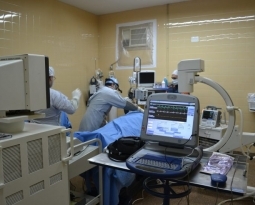Nebraska Patent of the Month – December 2021
If you have ever been out during a bad storm, there is a good chance you’ve seen traffic lights shaking in the wind. Traffic lights actually experience vibration and movement constantly but usually at a small enough degree that we don’t notice it. The most common structure for a traffic light is a single vertical pole and then a horizontal pole which extends the traffic light out and over the road, using cantilevered support structures to hold it up. This design uses minimal material and is quite reliable. However, with too much vibration over time, these structures can experience fatigue failures due to the constant stress.
There are existing methods and damping devices which decrease the amplitude of vibration and extend the service life of the structure, but most of these are limited to a small range of vibration amplitudes and may lack efficacy in real world applications.
Valmont Industries, Inc. has developed a vibration mitigation device which achieves energy dissipation through viscous or velocity dependent damping. Their device can be coupled to the horizontal support member. A tension spring is used either as a biasing member in a pneumatic process, an eddy current damping process, or a hybrid combination of these two damping processes. The pneumatic process is most effective for vibration mitigation in higher amplitudes while eddy current damping is effective in lower amplitudes.
The device is designed with a series of magnets housed in a reciprocating assembly. The magnets provide a magnetic field across a pair of conducting rods. The spring is set up to support the mangents and mass in a neutral position with respect to a vertical extension of the housing unit when the device is at rest. The design is slightly different if using an eddy current damping process but still uses the same basic components. In this way, a combination of processes can still be achieved.
Are you developing new technology for an existing application? Did you know your development work could be eligible for the R&D Tax Credit and you can receive up to 14% back on your expenses? Even if your development isn’t successful your work may still qualify for R&D credits (i.e. you don’t need to have a patent to qualify). To find out more, please contact a Swanson Reed R&D Specialist today or check out our free online eligibility test.
Who We Are:
Swanson Reed is one of the U.S.’ largest Specialist R&D tax advisory firms. We manage all facets of the R&D tax credit program, from claim preparation and audit compliance to claim disputes.
Swanson Reed regularly hosts free webinars and provides free IRS CE and CPE credits for CPAs. For more information please visit us at www.swansonreed.com/webinars or contact your usual Swanson Reed representative.

















